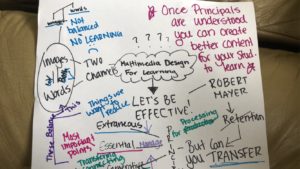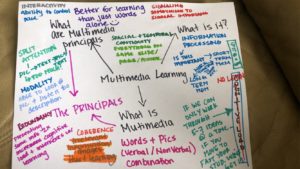Robert Mayer’s cognitive theory of multimedia principals of learning has been developed through connecting research behind how people learn and design for instruction (Cognitive Theory of Multimedia Learning, 2011). Through his applied research, Mayer constructed the following 10 principles of learning:
- Coherence Principle: students learn better when unecessary information and images are cut from the presentation

- Signaling Principle: Students learn better when a sign is implemented to signify important information.
- Redundancy Principle: When information is presented with visuals, text, and oral cues, the information can become overwhelming and redundant.
- Spatial Contiguity Principle: Information is better processed when the multimedia concepts are presented near each other on the screen.
- Temporal Contiguity Principle: Information is more effectively processed when animation and auditory information are presented simultaneously.
- Segmenting Principle: Learners better process information when broken into learning paced sections. This way their working memory has time to move the information to long term memory.

- Pretraining Principle: By providing students with key information prior to the animation, learners will be able to better understand the concepts they are learning.
- Modality Principle: Spoken text and graphics are more effective than text and graphics.
- Multimedia Principle: Universally, people learn better from verbal and non-verbal information than verbal alone.
- Personalization Principle: Learners better comprehend text when presented in conversational styles opposed to formal.
(Cognitive Theory of Multimedia Learning, 2011)
Mayer developed these ideas to support learners in processing information. The ten principles can be spilt up into three categories: principles to lessen extraneous information, principles to manage essential information, and principles to foster generative information (Cognitive Theory of Multimedia Learning, 2011).
I found this topic fascinating. In these unprecedented times, online learning has become more important than ever before. By working to apply these principles presented by Mayer, as teachers, we may be able to better reach and engage the needs of our students.
 I specifically found the coherence and redundancy principles relevant to my teaching style. I often find myself implementing unnecessary text, encouragement, and photos into presentations; I now realize, those extra pieces in my presentations may be overwhelming and distracting for students. Similarly, I often repeat myself multiple times or use more than one video to explain the same topic. In doing so, I most likely confuse my students instead of support their learning. Moving forward I plan to create more concise and to the point presentations.
I specifically found the coherence and redundancy principles relevant to my teaching style. I often find myself implementing unnecessary text, encouragement, and photos into presentations; I now realize, those extra pieces in my presentations may be overwhelming and distracting for students. Similarly, I often repeat myself multiple times or use more than one video to explain the same topic. In doing so, I most likely confuse my students instead of support their learning. Moving forward I plan to create more concise and to the point presentations.
Photo by Nathan Dumlao on Unsplash
References
Cognitive Theory of Multimedia Learning. (2011, July 3). Retrieved June 11, 2020, from http://etec.ctlt.ubc.ca/510wiki/Cognitive_Theory_of_Multimedia_Learning
Mayer, R. E. (2014). The Cambridge Handbook of Multimedia Learning. Retrieved from https://doi-org.ezproxy.library.uvic.ca/10.1017/CBO9781139547369


